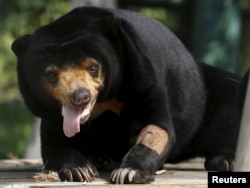Sun bears are the smallest of the world’s eight bear species. They usually live alone and are happy to spend most of their time by themselves when not looking for a mate. They spend their days in search of fruit, nuts, birds and insects in Southeast Asia’s tropical forests.
Although sun bears mostly live alone, scientists recently discovered they have developed a surprising social skill. They mimic, or copy, other bears’ facial expressions as a form of communication.
Researchers studied 22 sun bears during natural social play at the Bornean Sun Bear Conservation Center in Malaysia. The bears live in outdoor forest cages big enough to let the animals decide whether to play together or stay away from each other most of the day.
The bears mimicked not only the kind of expression, but also exact muscular movements the other bear made –such as raising or wrinkling their noses.
The ability to mimic facial expressions is found in humans, gorillas, orangutans, some monkeys and even domesticated dogs. But until now, only humans and gorillas showed the ability to exactly copy complex faces.
The study found that sun bears, however, are just as good at facial mimicry as humans and gorillas. This surprised researchers; not only are sun bears usually solitary, they also are not closely related to humans.
Derry Taylor is a doctoral student in psychology at the University of Portsmouth in England. He is one of the writers of the study, which was published in Scientific Reports.
Taylor said, “It seems that some forms of communication are much more widely shared amongst mammalian species than we previously thought.”
Sun bears have a black coat and a white or golden color on their mid-section. They live in trees and eat both plants and animals. They can grow to be up to 1.4 meters in height and 65 kilograms in weight.
Although they live alone in the wild, the bears in the study often played gently with each other. Sometimes they played with faster actions and behaviors such as hitting and biting.
It remains uncertain what messages the bears were sending to one another. But the facial copying might be a signal that they are ready to move from gentle to rougher play, Taylor suggested.
I’m Jill Robbins.
Will Dunham reported on this story for Reuters. Jill Robbins adapted it for Learning English. Ashley Thompson was the editor.
Have you ever noticed your dog or other pet copying facial expressions? How about other animals you see? We want to hear from you. Write to us in the Comments Section.
_____________________________________________________________
Words in This Story
mimic – v. to copy (someone or someone's behavior or speech)
wrinkle v. to cause (something) to develop wrinkles
domesticate – v. to breed or train (an animal) to need and accept the care of human beings
solitary – adj. tending to live or spend time alone
mammal – n. a type of animal that feeds milk to its young and that usually has hair or fur covering most of its skin








